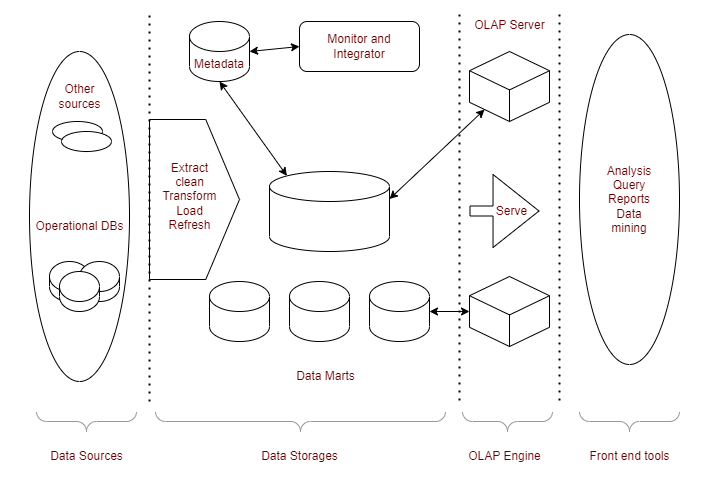
 Data Structure
Data Structure Networking
Networking RDBMS
RDBMS Operating System
Operating System Java
Java MS Excel
MS Excel iOS
iOS HTML
HTML CSS
CSS Android
Android Python
Python C Programming
C Programming C++
C++ C#
C# MongoDB
MongoDB MySQL
MySQL Javascript
Javascript PHP
PHP
- Selected Reading
- UPSC IAS Exams Notes
- Developer's Best Practices
- Questions and Answers
- Effective Resume Writing
- HR Interview Questions
- Computer Glossary
- Who is Who
Multi-tier architecture of Data Warehouse
In this article, we will discuss the Multi-tier architecture of Data Warehouse.
Introduction
A data warehouse is like a big storage house where information is kept so that people can use it to make better decisions. This information comes from different places like databases and other systems that keep track of transactions. It gets added to the warehouse regularly. The warehouse is a central place where all this data is organized and can be easily analyzed. It consolidates data from different sources. It transforms into a format that can be accessed and analyzed. To ensure the efficient functioning of a data warehouse, it must have a multi-tier architecture.
Need for Multi-tier Architecture
A data warehouse is a complex system. It requires multiple layers to handle the large amount of data involved. There is a need for a multi-level structure. Each layer of the system performs its specific function efficiently. A multi-tier architecture provides several benefits. These are: better data quality, faster query response time, better data integration and scalability.
Multi-tier Architecture
There are four layers in multi-tier architecture. These are : Data Source Layer, ETL Layer, Data Storage Layer, and Data Access Layer. These are explained below in brief.
Data Source Layer:
It is the first layer of a multi-tier architecture. It includes all sources of data that need to be integrated into the data warehouse. These sources can be databases, flat files or external sources such as social media platforms. The data source layer is responsible for collecting, validating and organizing the data before passing it on to the next layer.
ETL Layer
This is the second layer of the multi-tier architecture. It is responsible for extracting data from data sources. It transforms it into a format suitable for a data warehouse. It also loads it into the data storage layer. This layer ensures the quality and consistency of the data loaded into the data warehouse.
Data Storage Layer
This is the third layer of the multi-tier architecture. It is responsible for storing the data that has been transformed and loaded by the ETL Layer. This Layer can be divided into two sub-layers: the staging area and the data warehouse. The staging area is used to store the data temporarily before it is loaded into the data warehouse. The data warehouse is the final destination for the data and is used for reporting and analysis.
Data Access Layer
It is the fourth layer of the multi-tier architecture. It is responsible for providing users with accessibility to the data. This layer can be divided into two sub-layers ?
Presentation layer provides a user-friendly interface for users to access and analyze data.
Application layer is responsible for managing the business logic and ensuring the security and integrity of the data.
Multi-Tier Data Warehouse Architecture Components:
Multi-Tier Data Warehouse Architecture has the following components: Data Sources, Data Integration Layer, Staging Area, Data Warehouse Database, Data Mart, OLAP Cube, Front-End Tools, Metadata Repository.

Multi-Tier Data Warehouse Architecture can be divided into three main parts. These are: Bottom, Middle and Top tier. These are explained as follows below in brief.
Bottom Tier (Data Sources and Data Storage)
This layer consists of Data Sources and Data Storage. It is usually implemented using a warehouse database server, such as RDBMS. Gateways, such as ODBC, OLE-DB, and JDBC, are used to extract data from operational and external sources.
Middle Tier
This layer is an OLAP server. OLAP server can be implemented using either Relational OLAP (ROLAP) model or Multidimensional OLAP (MOLAP) model. ROLAP is an extended relational DBMS. That maps operations from standard data to standard data. While MOLAP is a special-purpose server that directly implements multidimensional data and operations.
Top Tier
This layer is a front-end client layer. It has query and reporting tools, analysis tools, and data mining tools, such as trend analysis and prediction.
Data Warehouse Models
There are three types of Data Warehouse Models from an architectural perspective ?
Enterprise Warehouse
It collects data from all parts of the organization and integrates it to provide a complete picture of the organization.
It can be very large and complex, and requires extensive modeling and design to implement.
Data Mart
It contains a subset of data from the Enterprise Warehouse that is specific to a particular group of users.
It is smaller and easier to implement than an Enterprise Warehouse, and is typically used for department-level reporting and analysis.
Virtual Warehouse
It is a set of views on top of an operational database, rather than a separate database.
It is easy to create, but requires additional capacity on operational database servers to support efficient querying.
Advantages of Multi-tier Architecture
These are main advantages of Multi-Tier Architecture of Data Warehouse ?
Scalability
Components can be added, deleted or updated according to the data warehouse's needs.
Better Performance
Several layers enable parallel and efficient processing for improved performance and reaction times.
Modularity
Modular design allows the creation, testing, and deployment of separate components.
Security
Applying security measures to various layers enhances the data warehouse's overall security.
Improved Resource Management
Different tiers can be tuned to use proper hardware resources, reducing expenses and increasing effectiveness.
Easier Maintenance
Individual components can be updated or maintained without affecting the entire data warehouse.
Improved Reliability
Multi-tier architecture offers redundancy and failover capabilities, enhancing the overall reliability of the data warehouse.

